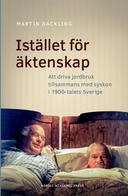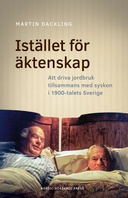Explore

1900-talet sägs ibland vara familjejordbrukets århundrade. Trots att landsbygden förändrades i grunden framställs ofta själva bondefamiljen – bestående av man, hustru och barn – som intakt. Alla jordbruk drevs dock inte av familjer av den traditionella sorten. Ett alternativ var att två eller flera av barnen tillsammans övertog gården, fortsatte bo ihop och förblev ogifta. Men hur vanliga var sådana syskonjordbruk? Hur fungerade de och vilka var motiven bakom syskonens levnadsval?
Med hjälp av hushållsanalyser, statliga utredningar och intervjuer tecknar historikern Martin Dackling i Istället för äktenskap för första gången historien om syskonjordbruken. Han visar att de varken var ovanliga eller utgjorde kvarlevor från ett äldre bondesamhälle. Från att tidigare knappt ha existerat blev det från slutet av 1800-talet allt vanligare att bröder och systrar drev gårdar ihop och under 1930- och 1940-talet var de ett mycket vanligt inslag på svensk landsbygd. Efter 1950 blev de dock successivt allt ovanligare. I boken förs en diskussion om varför syskonjordbruken uppstod och Dackling pekar både på kulturella, sociala och ekonomiska delförklaringar. En viktig omständighet var också att de flesta syskonen förblev ogifta. Kärleksrelationer saknades inte, men giftermål var svårt att kombinera med flera hemmaboende syskon. Kärleks- och syskonrelationerna stod i ett komplicerat förhållande till varandra och på många gårdar blev syskonjordbruk ett alternativ till äktenskap.
***
The 20th century is sometimes said to be the century of the family farm. Although the countryside changed fundamentally, the farming family - consisting of husband, wife and children - is often seen as intact. However, all farms were not driven by families of the traditional type. One alternative was that two or more of the children took over the farm together, continued to live in the same household and remained unmarried. But how common were such sibling farms? How did they work and what were the motives behind the siblings' choice to live together?
Based on household analyzes, government reports and interviews, historian Martin Dackling in Instead of marriage sketches the history of the sibling farms. He shows that they were neither unusual nor remains of an older peasant society. From the beginning of the 19th century, it became increasingly common for brothers and sisters to take over the farm together and in the 1930s and 1940s sibling farms were a common feature of Swedish countryside. However, after 1950 they became increasingly unusual. The book discusses why the sibling farms arose and Dackling points to cultural, social and economic explanations. An important circumstance was also that most of the siblings remained unmarried. Love relations were not missing, but marriage was difficult to combine with siblings living in the same household. Love relations and sibling relations were in a complicated correlation with each other, and on many farms, living with siblings became an alternative to marriage.
This book is included in DOAB.
Why read this book? Have your say.
You must be logged in to comment.
Rights Information
Are you the author or publisher of this work? If so, you can claim it as yours by registering as an Unglue.it rights holder.Downloads
- 74 - pdf (CC BY-NC-ND) at Unglue.it.
Keywords
- 1900-tal
- 20th century history: c 1900 to c 2000
- äktenskapsmönster
- arvsförhållanden
- egendomsrelationer
- familj
- familjehistoria
- Family and household
- History
- History: earliest times to present day
- History: specific events & topics
- Humanities
- hushåll
- inheritance
- jordbruk
- lantbruk
- marriage patterns
- muntlig historia
- Property relations
- Rural communities
- Rural conditions
- Sibling relations
- Social & cultural history
- Social groups
- Society & culture: general
- Society & Social Sciences
- syskon
- syskonjordbruk
- thema EDItEUR::3 Time period qualifiers::3M c 1500 onwards to present day::3MP 20th century, c 1900 to c 1999
- thema EDItEUR::J Society and Social Sciences::JB Society and culture: general::JBS Social groups, communities and identities::JBSC Rural communities
- thema EDItEUR::N History and Archaeology
- thema EDItEUR::N History and Archaeology::NH History::NHT History: specific events and topics
- thema EDItEUR::N History and Archaeology::NH History::NHT History: specific events and topics::NHTB Social and cultural history
Links
DOI: 10.21525/kriterium.12web: http://www.kriterium.se/site/books/10.21525/kriterium.12/
Editions


